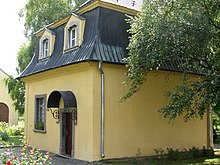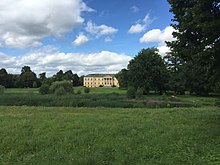Dolná Krupá Castle
The Dolná Krupá Castle (Hungarian Alsókorompa, German Unterkrupa) is located in what is now western Slovakia in the village of the same name , about 13 km from the western Slovak city of Trnava (Hungarian Nagyszombat, German Tyrnau). It is the former aristocratic residence of the Hungarian count family Brunsvik .
Known by other names
Different spellings have become established: Brunswick, Brunswik, Brunszvik, Prunswick, etc. Over the centuries the family name has been written in around forty different spellings.
history
The Brunsviks
The history of the castle in Dolná Krupá (German Unterkrupa, Hungarian Alsókorompa) is closely connected with the Hungarian noble Brunsvik family. The family came from Germany ( Stettin ) and can be traced for the first time in the Kingdom of Hungary with Tobias Brunsvik (~ 1590 - ~ 1670), who settled in Freistadt an der Waag . His grandson Michael II. Brunsvik (1671–1719) married Margarethe Theresia Vitalis von Vitalisfalva (~ 1685–1747) around 1710, who brought the reign of Unterkrupa as a dowry into the marriage.
Their son Anton I. Brunsvik (1717–1780) studied law at the University of Tyrnau and inherited the rule of Unterkrupa. Between 1749 and 1756 he had a new baroque building built on the site of the old palace according to plans by the imperial court architect Johann Baptist Martinelli . For his services (he worked for the Hungarian Court Chancellery in Vienna ), Anton I was elevated to the rank of count by the Empress Maria Theresa in 1775 and was therefore also allowed to use the nobility predicate 'de Korompa' in his name (Hungarian version of Unterkrupa). He also received the rule Maronvásár as a fief .
After the death of Anton I, the family property was divided among his sons (by drawing lots) in 1783. Anton II (1745–1793) received the rule of Mártonvásár and the younger son Joseph (1750–1827) the property of Unterkrupa.
Between 1792 and 1796, Joseph had Unterkrupa Castle rebuilt in Baroque (but already with classicist elements) according to plans by the architect of the Hungarian Royal Chamber, Johann Joseph Thalherr . The newly created ensemble included a theater building (demolished in 1937), an orangery , a bath house and a gardener's house. A few years later (around 1813) he commissioned the only 24-year-old Austrian architect Anton Pius Riegel with further construction work on the castle, who rebuilt it in the style of modern classicism . An English park with a size of 247 hectares was built between the years 1813 and 1819 at the request of the client . The German garden and landscape architect Christian Heinrich Nebbien was commissioned with the work . The park was finished in 1822, which can be seen from the garden plans that have been preserved.
The park was one of the most important examples of landscape architecture in the entire then Kingdom of Hungary . It had a refined artificial water system with three artificial ponds : the “Great Pond” in the middle of which there was an artificial island, the “Luisen Island”, which was supposed to commemorate the couple's daughter Luise, who died at an early age. In addition, two smaller ponds were created (the "turtle pond" and the "trout pond"). There was also an artificial grotto and the park was decorated with numerous sculptures by well-known sculptors. Of these architectural elements, only the obelisk has been preserved at the top of which is the sculpture “Mother with Child”, the work of the important Hungarian sculptor István Ferenczy (1792–1856). From the time of the Brunsviks, a 'giant sequoia' ( Sequoiadendron giganteum ) has been preserved, which today has a height of 45 m and a diameter of 4 meters. (Is under nature protection as it is one of the largest of its kind.)
The members of the Brunsvik family were also important art lovers and patrons. The family was particularly interested in music. In the in-house theater, plays were performed in which the family members also played. Based on the family ties to the brother of the lord of the castle Anton II. Brunsvik (the lord of Mártonvásár), the family also came into contact with Ludwig van Beethoven . Beethoven also visited Unterkrupa in 1800, 1801 and 1806. Through the sisters Therese and Josephine Brunsvik , Beethoven also met their cousin Countess Giulietta Guicciardi (1782–1856) and gave her piano lessons in Unterkrupa. He also dedicated the moonlight sonata to her , some of which he is said to have composed in Unterkrupa.
The Choteks
Joseph Brunsvik's daughter Henriette (1789–1857) married Hermann Chotek von Chotkov and Vojnin (1786–1822), the offspring of an old Bohemian noble family, on January 22, 1813. Through this marriage, the lordship of Unterkrupa passed into the possession of the Chotek family . The Choteks sustainably promoted agriculture and livestock in Unterkrupa.
Marie Henriette Countess Chotek (1863–1946) made particular contributions . She was the granddaughter of Hermann Chotek and Henriette Brunsvik and second cousin of Archduchess Sophie Maria Chotek , who tragically died with her husband, heir to the throne Franz Ferdinand of Austria-Este , in the assassination attempt in Sarajevo on June 28, 1914. At the end of the 19th century, Marie Henriette began building a private rose garden in her grandfather's park . That is why she was nicknamed "Rose Countess".
After Rudolf Geschwind's death, the countess acquired a large part of his roses. It is thanks to Marie Henriette Chotek that there are still 28 Geschwind varieties today. A catalog from 1929 records 8000 roses that were grown by the Countess in Unterkrupa alone. The rose breeder Peter Lambert dedicated the rose 'Marie Henriette Countess Chotek' to her as early as 1920. In 1934 the countess got into financial difficulties, which marked the beginning of the decline of one of the most famous rosalia in this region.
The rose garden in Unterkrupa is mentioned for the last time in an article by Dr. Rudolf Limbacher mentions: "The pink of the city of Pressburg ".
1918 and 1945 and the time thereafter
The collapse of the Danube Monarchy already marked a turning point for Unterkrupa. The former 'Unter-Korompa' (Hungarian 'Alsókorompa'), which belonged to the Kingdom of Hungary, was now called 'Dolná Krupá' and belonged to the newly founded Czecho-Slovakia (1918).
In 1923 part of the Chotek property was expropriated as part of a land reform carried out by the new Czech-Slovak state . Two years later, the Chokes had to cede 518 hectares of their property and four farms to the state. This was followed by a legal dispute that lasted for years and only ended with a settlement on June 12, 1933.
After the Second World War , however, the actual destruction of Unterkrupa began. The preserved objects of the former property are now only a torso of a valuable monument. After the invasion of the Red Army , large parts of the park were devastated. The former manor house was looted and the inventory stolen, the now elderly rose countess was driven from the castle and could be hidden and housed by a well-disposed peasant family in the village. (Although she descended from an old Bohemian (Czech) noble family, she was supposed to be resettled “as a German” based on the Beneš decrees ). In 1946 she died completely impoverished and lonely in Unterkrupa and was buried in the town's Chotek mausoleum .
In the 1950s, a lunatic asylum was set up in the mansion by the communist rulers of that time in Czecho-Slovakia . It later became a home for composers.
Of the great English park only a torso of about 17 hectares remained. The remaining areas were used for communist agriculture (as kolkhozes ; Slovak JRD: "Jednotné roľnické družstvo"), the processing was carried out by a "socialist collective ".
After the fall of 1989/1990, the now totally neglected property was taken over by the Slovak National Museum and built a music museum there. Old musical instruments are shown in the manor house and it has become a memorial for famous music composers living in Slovakia, such as: B. Ernst von Dohnányi , Alexander Albrecht and Franz Schmidt . In 1992, a small Beethoven memorial museum was set up in the gardener's house, in which the composer's relations to old Hungary (and today's Slovakia ) are particularly emphasized.
Efforts are being made to renovate the buildings of the castle and its outbuildings and to restore at least part of its original splendor to the park. The “Big Pond” with the Luisen Island has already been restored.
Web links
- Familypedia Brunswick by Korompa family , (English, online, accessed September 5, 2017)
- Muzeum.SK - Katieľ v Dolnej Krupej; (Slovak, online, accessed September 7, 2017)
- www.welt-der-rosen.de → People → Marie Henriette Countess Chotek (online, accessed on September 7, 2017)
Individual evidence
- ↑ "Brunszvikok, ó nemes Brunszvikok!" (Hungarian; www.sulinet.hu → Martonvasar, online: accessed on September 5, 2017)
- ↑ According to other sources, the elevation to the count status is said to have taken place at the instigation of Emperor Joseph II , who was co-regent of Maria Theresa at this time.
- ↑ Anton II had a career similar to that of his father. After training at the Theresianum in Vienna and the University of Tyrnau, he entered the service of the Hungarian Court Chamber. In 1744 he married the Pressburg lady-in-waiting Elisabeth Freiin Wankel von Seeberg (1752-1830) with whom he had the children Therese , Franz , Josephine and Karoline. He took an active part in the reform plans of Emperor Joseph II and in 1790 was appointed Chief Count of Bars County.
- ↑ Joseph Brunsvik's widow, Josepha Maria Anna Majthényi von Kesselökeö (1769 - 1851) had the sculpture erected in memory of her deceased husband. At the same time, it should represent a homage to the Creator.
- ↑ The Guicciardis were related to the Brunsviks. Susanne Brunsvik (~ 1746-1800) was a sister of Anton II and Joseph was married to Franz Joseph Guicciardi (1740-1800).



